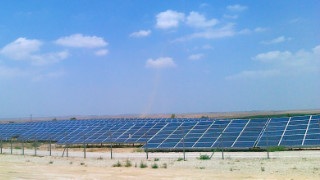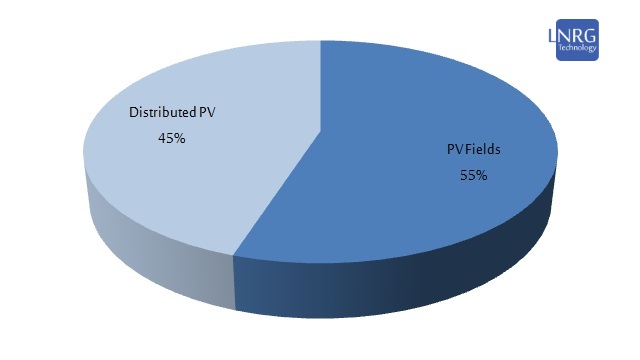
This report summarizes the 2018-2019 developments in the solar photovoltaic (PV) segment in Israel and provides updated integration figures on solar PV electric capacity, generation, regulation and tariffs. Solar photovoltaic (PV) facilities are continuing to form a dominant share of new capacity additions in the electricity generation segment in Israel and worldwide. The total capacity of grid-connected solar PV facilities in Israel was 1,243 MWp by the end of 2018 and is expected to surpass 1,600 MWp by the end of 2019. The capacity of PV facilities increased by 29% year-over-year from the end of 2017 to the end of 2018 - a significant surge from previous 12% annual growth rate. In terms of electric generation, solar PV facilities produced 1,747 million kWh in 2018 – an increase of 10% from 1,584 million kWh in 2017, also a surge from previous moderate 3% growth rate. The percentage of solar PV generation out of total electricity generation in the country increased from 2.3% in 2017 to 2.5% in 2018 and is expected to reach nearly 4.0% in 2019.
Solar photovoltaic (PV) technology is continuing to form the dominant share of new capacity additions in the electricity generation segment in Israel and worldwide. The global rate of PV deployment has grown exponentially for many years, due to a strong demand for a modular, cheap, reliable and environmentally clean technology for electricity production. PV facilities are utilized for both off-grid energy generation in remote areas, but mainly for grid-connected applications. In Israel, added PV capacity was at 280 MWp in 2018, forming more than 55% of added electric capacity. Moreover, complementary technologies have also been introduced into the market over the past several years, including distributed energy harvesting hardware (DC maximizers and micro-inverters), facility planning software solutions, real-time smart monitoring and more. Those complementary solutions assist in integrating more solar PV facilities into the grid and reducing construction and operation costs. While distributed electricity storage solutions have already appeared on the market, they are still a marginal phenomenon. However, further evolution of electricity storage technology would also drive higher levels of PV integration.
Grid-connected solar PV facilities were introduced into Israel in summer 2008, with the first government-subsidized feed-in tariff program for small commercial and residential facilities. Since then, solar PV installations have been ongoing across the country, producing a constantly growing capacity of grid-connected facilities. In 2009, governmental decision #4450 determined a target of 5% renewable electricity production by the year 2014 and 10% renewable electricity production by the year 2020, largely relying on integration of solar energy. Though the 2014 target was missed, two important decisions complemented the previous solar PV deployment plans: one diverting much planned capacity from solar thermal and other renewable technologies to solar PV and another decision (accepted towards the 2015 Paris Climate Summit) setting the targets for renewable electricity production in Israel at 17% by 2030. Altogether the planned framework in line with modified regulations and new financial models is expected to bring Israel to 5% renewable electricity target by December 2019 and may get Israel close to its 2020 target of 10%.

Figure 1. Structure of Solar PV segment in Israel on December 2018 - share of distributed (residential & commercial) and solar fields (industrial & utility scale).
The distribution of solar PV facility sizes in Israel very much resembles EU and US markets. The proportion of distributed PV in Israel, including residential and commercial roofs (up to 1 MWp), is 45% as of December 2018; whereas the rest is PV fields including industrial (1-10 MWp) and utility-scale (more than 10 MWp). In comparison, the proportion of distributed PV in Germany was recently reported to be 52%, while in US it was around 40%. It should be mentioned that Net Metering facilities in Israel were all counted as "distributed" even though some are in fact industrial-scale, due to the fact that Israeli authorities have not made the distinction within the Net Metering program.
Within Israel, one can encounter solar facilities all over the country, though several challenges still exist ahead of converting PV technology into mainstream means for electricity generation. Since the introduction of the first solar tariff program in 2008, a notable number of various programs and initiatives have evolved. By 2019, 6 feed-in-tariff programs for small-scale PV facilities have already been implemented, with the seventh FIT program ongoing since August 2018. In addition, one feed-in-tariff quota for medium-sized commercial PV facilities, as well as medium-sized land tenders program and a feed-in-tariff quota for utility-scale PV facilities had been implemented. From 2014 to 2018, Israeli Electricity Authority also introduced Net Metering quota of 400 MWp for residential and commercial PV facilities, issued two tenders for Ashalim solar PV fields and provided licenses to several utility-scale solar PV projects. Finally, in 2018, the Electricity Authority also added an unlimited self-consumption "default" scheme for distributed grid-connected PV facilities and initiated a series of tenders for commercial and utility-scale PV facilities.

Figure 2. Solar PV new annual installations (blue) and total PV capacity by the end of each calendar year (purple) in MWp. 2019-20 figures are an estimate.
The total capacity of grid-connected PV facilities in Israel was at 1243 MWp by the end of 2018 and is expected to surpass 1,600 MWp by the end of 2019. The capacity of PV facilities increased by 29% year-over-year from the end of 2017 to the end of 2018 - a significant surge from previous 12% annual growth rate. Solar PV segment made up 6.9% of grid-connected electric capacity in Israel by the end of 2017 (up from 4.9% in the end of 2016 and 5.4% in the end of 2017) and is expected to reach over 10.0% by the end of 2019.

Figure 3. Annual electricity production by the solar PV segment in Israel (purple) in millions of kWh. 2019-20 figures are an estimate.
In terms of electric generation, solar PV facilities produced 1,747 million kWh in 2018 – an increase of 10% from 1,584 million kWh in 2017, also a surge from previous moderate 3% growth rate. The percentage of solar PV generation out of total electricity generation in the country increased from 2.3% in 2017 to 2.5% in 2018 and is expected to reach nearly 4.0% by the end of 2019. In 2019, solar PV generation is hence expected to surpass 2,500 million kWh. Solar PV segment is responsible for the majority of renewable electricity generation in Israel, which altogether reached the level of 2,038 million kWh in 2018, up from 1,786 million kWh in 2017.
The extended commercial report can be purchased at LNRG Technology digital store.
















